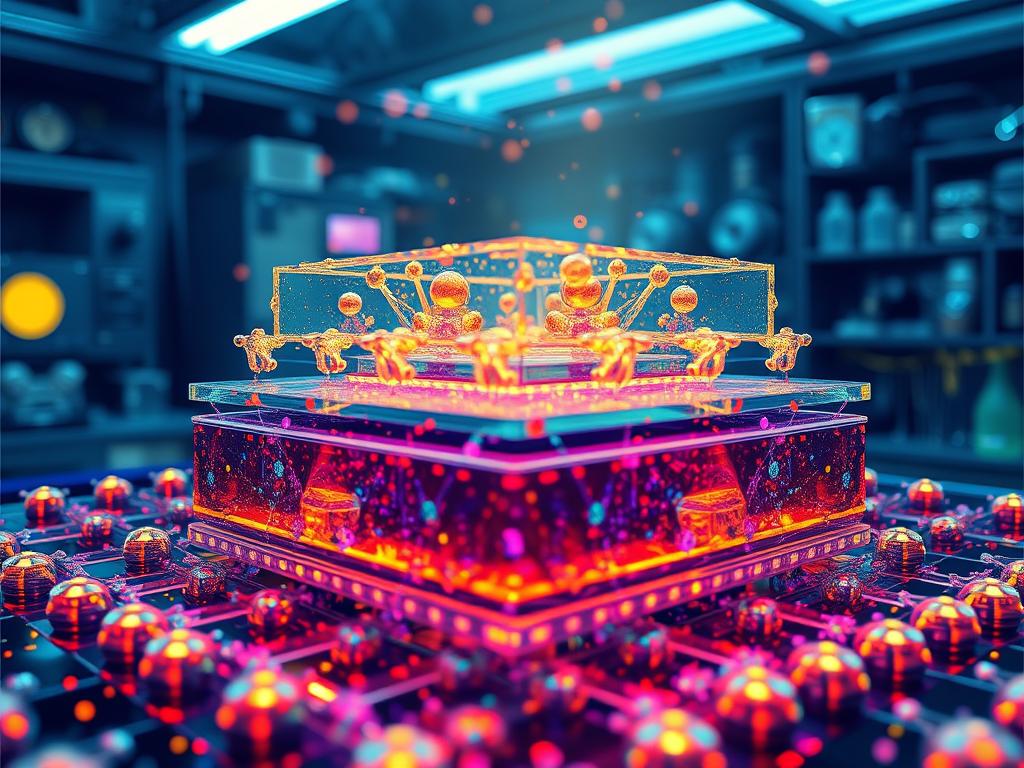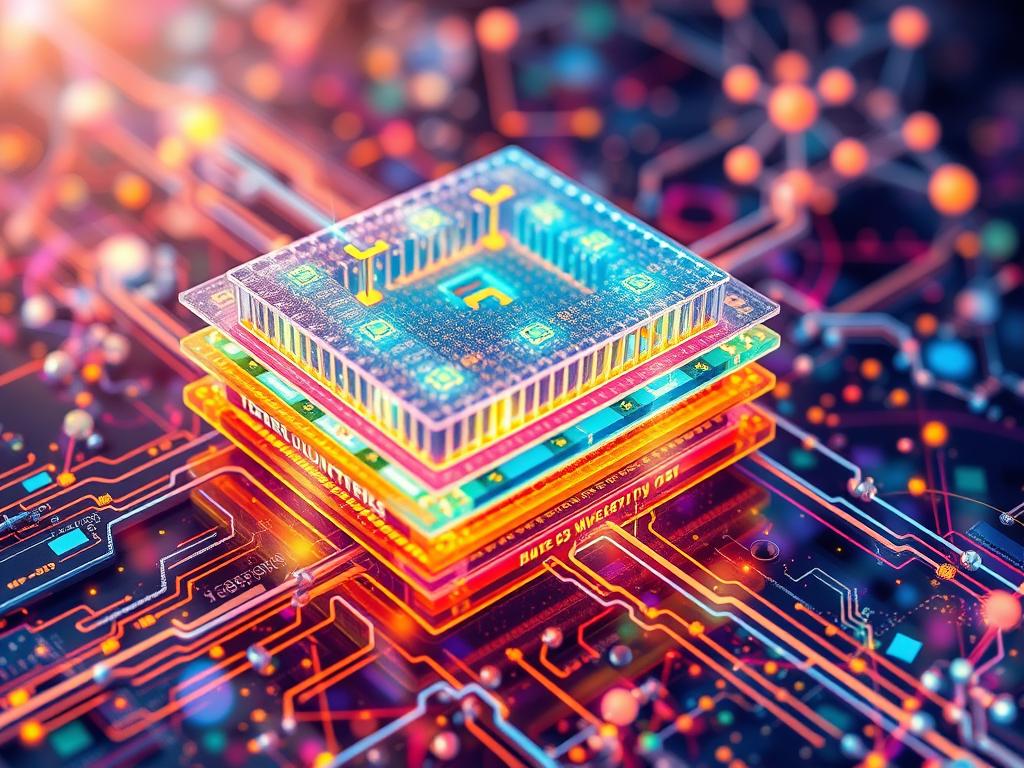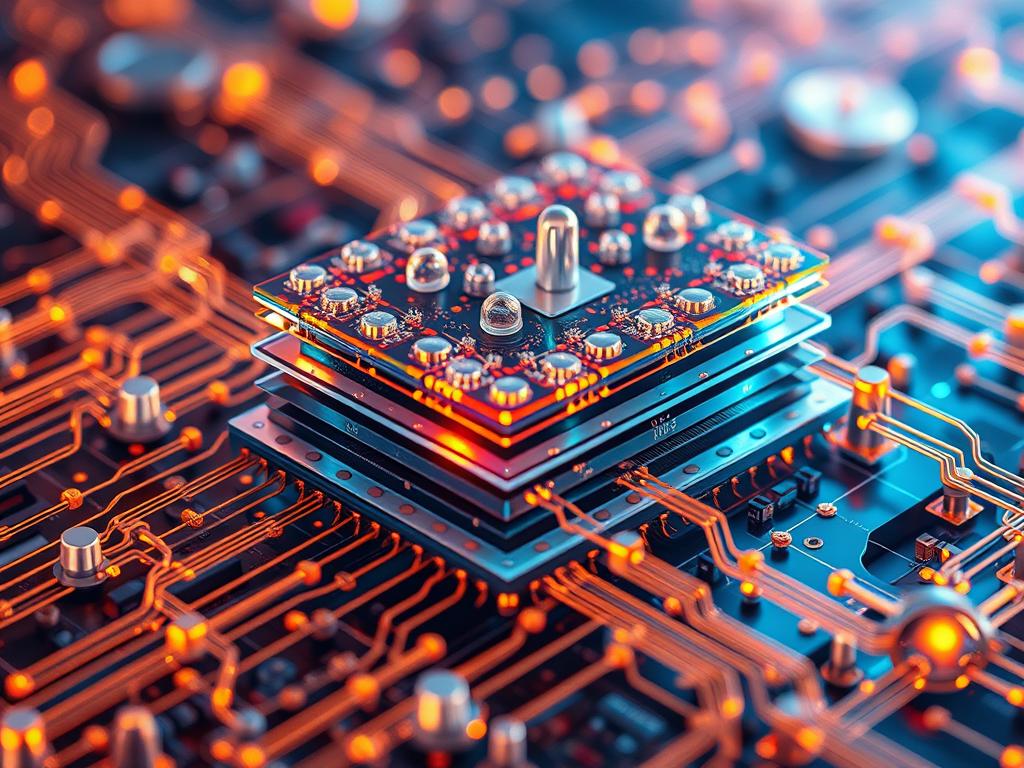2D heterojunctions are set to revolutionize transistor technology. These innovative structures use layered crystals to improve channel control in semiconductor devices. They could overcome the limits of traditional silicon-based transistors, leading to next-generation electronics.
Layered crystals offer unmatched control over electron flow in transistor channels. This results in better performance and lower power use. It also allows for ultra-thin, flexible devices.
Researchers are exploring the vast potential of 2D materials in transistor technology. This work is changing how we design and make semiconductors.
Scientists and engineers are creating heterojunctions with amazing features. These use the atomic-scale thickness and diverse electronic properties of 2D materials. They allow precise control of charge carriers.
This opens up new paths for high-performance computing and energy-efficient electronics. It also enables new applications in flexible and wearable tech.
Heterojunction Physics
2D heterojunctions are vital for layered crystal transistors. They use unique properties from combining materials at the atomic scale. These devices offer exciting possibilities for advanced electronics.
Band Alignment
Band alignment is crucial for carrier behavior in heterojunctions. It affects how electrons flow when two 2D materials meet. This impacts van der Waals integration and device efficiency.
Interface States
The interface between layers can host electronic states. These states may trap carriers or help them move across the junction. Careful engineering of interfaces is key to optimizing carrier transport.
Transport Mechanisms
Carriers move through 2D heterojunctions in various ways. Tunneling, thermionic emission, and drift-diffusion all play important roles. Understanding these processes helps design efficient transistors with better switching abilities.
- Tunneling: Quantum mechanical effect allowing carriers to pass through potential barriers
- Thermionic emission: Thermal excitation of carriers over potential barriers
- Drift-diffusion: Movement of carriers due to electric fields and concentration gradients
Mastering band alignment, interface states, and transport mechanisms is crucial. It unlocks the potential of 2D heterojunction transistors. This knowledge paves the way for next-generation electronics.
Material Integration
Building 2D heterojunction transistors needs careful material integration. This involves layering different 2D materials for high-performance devices. Mastering layer assembly, interface engineering, and defect management is crucial.
Layer Assembly
Assembling 2D material layers is a delicate process. Scientists use van der Waals integration to stack these ultra-thin layers.
This method allows precise control over the device structure. It enables the creation of unique properties not found in individual materials.
Interface Engineering
Interface engineering is vital for device performance. It optimizes the boundary between different 2D materials.
Researchers focus on minimizing defects and ensuring smooth electron flow. This process is key for creating high-speed, efficient transistors.

Defect Management
Defects can greatly impact device stability and performance. Effective defect management strategies are essential.
- Carefully controlling growth conditions
- Using post-fabrication treatments
- Employing buffer layers to reduce strain
These techniques help maintain 2D layer integrity. They also improve overall device reliability.
| Integration Aspect | Key Technique | Impact on Device |
|---|---|---|
| Layer Assembly | Van der Waals integration | Precise structure control |
| Interface Engineering | Boundary optimization | Enhanced electron flow |
| Defect Management | Growth control and treatments | Improved stability |
Mastering these integration techniques is crucial. It allows researchers to create superior 2D heterojunction transistors.
This advancement paves the way for next-gen electronic devices. These devices will have unprecedented capabilities.
Device Architecture
2D heterojunction transistors rely on unique stack designs for top performance. These devices use special layer arrangements to boost carrier transport and channel control. Let’s look at the key parts of these advanced transistors.
Stack Design
2D heterojunctions use carefully layered materials for the best electronic properties. A typical stack has a semiconductor layer between insulating layers. This setup allows precise control of carrier movement in the device.
Contact Engineering
Good contact engineering is key for top device performance. Engineers work to create low-resistance contacts to cut energy loss. They often use special materials to blend seamlessly with the 2D layers.
Gate Control
The gate in these transistors is the main way to control the channel. Engineers can change carrier flow by applying voltage to the gate. This control is crucial for fast switching and low power use.
| Component | Function | Impact on Performance |
|---|---|---|
| 2D Layers | Form the active channel | Enhance carrier mobility |
| Contacts | Enable current flow | Reduce energy loss |
| Gate | Control carrier density | Improve switching speed |
By fine-tuning these parts, engineers create better 2D heterojunction transistors. These improvements lead the way for cutting-edge electronic devices.
Performance Analysis
2D heterojunction transistors offer impressive gains in key performance areas. They excel in carrier transport, stability, and channel control. These devices set new benchmarks for electronic components.
Channel Properties
2D materials’ unique structure enables superior channel properties. Carrier transport in these devices approaches ballistic limits, boosting overall efficiency. Their atomically thin channels allow precise control over electron flow.
This results in improved performance and reduced power consumption. The enhanced control leads to more efficient operations in various applications.
Switching Behavior
2D heterojunction transistors show exceptional switching behavior. Sharp band edges and fewer trap states lead to faster on/off transitions. This rapid switching is vital for high-speed computing and signal processing.

Power Efficiency
2D heterojunction transistors offer significant power efficiency advantages. Superior channel control and less leakage current result in lower power use. This efficiency improves battery life in portable devices.
It also reduces energy costs in large-scale computing systems. The power savings make these transistors ideal for various applications.
| Performance Metric | 2D Heterojunction Transistors | Traditional Transistors |
|---|---|---|
| Carrier Mobility | High (>10,000 cm²/Vs) | Moderate (1,400 cm²/Vs) |
| Switching Speed | Ultra-fast (sub-picosecond) | Fast (picosecond range) |
| Power Consumption | Very Low | Moderate |
| Channel Thickness | Atomically thin (1-3 nm) | Several nanometers (5-10 nm) |
Manufacturing Process
Making 2D heterojunction transistors requires precise and innovative methods. These processes have improved to meet production challenges while maintaining quality. They aim to scale up for commercial use without compromising performance.
Material Growth
High-quality 2D materials are crucial for these transistors. Chemical vapor deposition (CVD) is a common technique for producing uniform layers. CVD-grown 2D sheets can be adapted for various substrates and heterojunctions.
This method offers flexibility in device design. It allows for customization based on specific needs.
Transfer Methods
After growth, 2D materials are transferred onto the desired substrate. Van der Waals integration is key for assembling atomically thin layers. This technique preserves the unique properties of each material.
It ensures stability in the heterojunction stack. The intrinsic characteristics of materials remain intact during this process.
Quality Control
High standards are crucial for device performance. Quality control measures include several techniques.
- Atomic force microscopy for surface analysis
- Raman spectroscopy to verify material composition
- Electrical testing to ensure proper interface engineering
| Process Step | Duration | Key Consideration |
|---|---|---|
| Material Growth | 2-4 hours | Temperature control |
| Transfer | 1-2 days | Contamination prevention |
| Quality Control | 1-3 days | Non-destructive testing |
The manufacturing process usually takes 1-3 weeks. This timeframe depends on the heterojunction’s complexity and customization needs. Improvements in interface engineering keep enhancing device stability and performance.
Application Domains
2D heterojunction transistors are changing many tech fields. They use special properties to boost performance in various applications. These innovations are reshaping key sectors in exciting ways.
High-Performance Logic
2D heterojunctions excel at channel control in computing. This allows for faster carrier transport, enabling high-speed logic operations. The result is computers that process data much faster.
This opens doors to advanced AI and machine learning applications. These transistors are pushing the limits of computing power.

Flexible Electronics
2D heterojunctions are ultra-thin, making them perfect for flexible electronics. They can be used in bendable displays and wearable devices. These transistors even work well in electronic skin.
Their ability to perform under stress is impressive. This makes them ideal for creating durable, lightweight gadgets.
Sensors
2D heterojunctions excel in sensor applications. They’re highly sensitive to environmental changes. This allows for the creation of ultra-precise sensors.
These transistors can detect tiny chemical amounts. They can also measure subtle physical forces. This pushes the limits of sensing technology.
“2D heterojunction transistors are not just an incremental improvement – they’re a quantum leap in electronic device capabilities.”
Research on 2D heterojunctions continues to advance. We’ll likely see them in more diverse applications soon. They could be used in energy-efficient smart homes.
Next-generation medical devices might also use this technology. The future of electronics looks bright with 2D heterojunctions.
Testing and Validation
Testing and validation are vital for 2D heterojunction transistors. These processes ensure devices meet standards for electrical properties, interface quality, and stability. They help assess the performance of these innovative transistors.
Electrical Properties
Measuring electrical properties is key to evaluating transistor performance. This includes assessing carrier transport characteristics, which show how electrons or holes move through the device.
Researchers use various techniques to measure important parameters. These include mobility, on/off ratio, and threshold voltage.
| Property | Measurement Technique | Significance |
|---|---|---|
| Carrier Mobility | Hall Effect Measurements | Indicates charge carrier speed |
| On/Off Ratio | Current-Voltage (I-V) Curves | Shows switching effectiveness |
| Threshold Voltage | Transfer Characteristics | Determines activation point |
Interface Quality
Interface engineering is crucial for optimizing device performance. Evaluating interface quality involves examining the heterojunction’s atomic structure and chemical composition.
Advanced microscopy and spectroscopy techniques help identify defects or impurities. These issues could impact the device’s functionality.
Reliability Assessment
Ensuring long-term stability is essential for practical applications. Reliability tests subject devices to extreme conditions like high temperatures or electrical stress.
These assessments help predict device lifespan and identify potential failure modes. Recent studies show promising results in enhancing heterojunction device stability.
Careful material selection and processing techniques have improved device performance. These advances bring us closer to next-generation electronics.
“Thorough testing and validation are the cornerstones of developing reliable and high-performance 2D heterojunction transistors for next-generation electronics.”
Future Outlook
2D heterojunction transistors are poised to revolutionize the semiconductor industry. Researchers are exploring ways to enhance channel control through these innovative devices. This paves the way for more efficient and powerful electronics.
Material Development
Scientists are creating new 2D materials with unique properties. These could improve van der Waals integration in transistors. The aim is to boost performance and cut power use in future devices.
Device Innovation
Engineers are designing novel transistor structures using 2D heterojunctions. These designs aim to overcome limitations in traditional silicon-based devices. The focus is on better channel control and reducing leakage current.
Market Applications
2D heterojunction transistors have vast potential applications. They could transform industries from high-performance computing to flexible electronics. As the technology advances, we’ll see them in various fields.
These devices may soon appear in high-frequency applications, ultra-low power sensors, and advanced logic circuits. The future looks bright for this groundbreaking technology.


